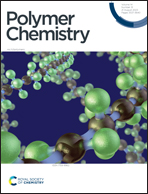Novel covalent adaptable networks (CANs) of ethylene/1-octene copolymers (EOCs) made by free-radical processing: comparison of structure–property relationships of EOC CANs with EOC thermosets†
Abstract
Ethylene-based copolymers such as ethylene/1-octene copolymers (EOCs) are commonly used in blends for thermoplastic elastomers, foams, and consumer articles. These blends may be permanently cross-linked to enhance elasticity at the expense of their recyclability. Literature studies on structure–property relationships between precursor EOCs and their permanently cross-linked counterparts (EOCXs) are conflicting. Additionally, few studies have sought to overcome the recyclability issues of EOCXs by incorporating dynamic bonds into their structures to produce EOC covalent adaptable networks (EOC CANs). Here, we synthesized several EOCXs and EOC CANs from EOCs of varying 1-octene content and melt flow index (MFI) using a simple, radical-based reactive process. The EOC CANs are made capable of dialkylamino disulfide dynamic covalent chemistry by incorporation of dissociative bis(2,2,6,6-tetramethyl-4-piperidyl methacrylate) disulfide (BiTEMPS methacrylate) cross-links during reactive processing. Increasing the 1-octene content and MFI in EOCs generally reduces the grafting efficiency of BTMA and cross-link density in EOCXs and EOC CANs. Decreasing cross-link density in EOC CANs results in greater losses of cross-link density with increasing temperature from the dissociative BiTEMPS methacrylate cross-links as well as shorter stress relaxation times. Stress relaxation activation energies in EOC CANs generally align with previously reported bond dissociation energies and activation energies associated with BiTEMPS-related molecules and CANs. While EOCXs could not be reprocessed into healed films, our EOC CANs are reprocessable and fully recover their cross-link densities and thermomechanical properties within error after successive compression molding cycles.



 Please wait while we load your content...
Please wait while we load your content...